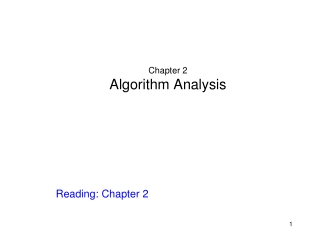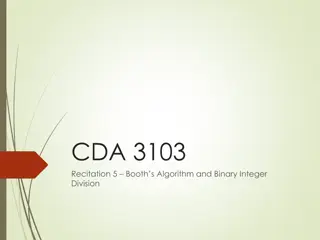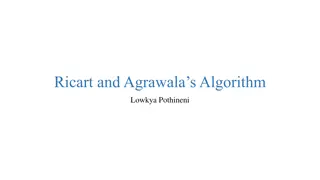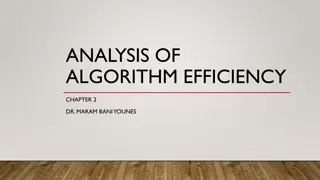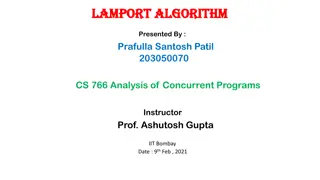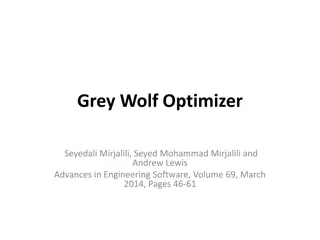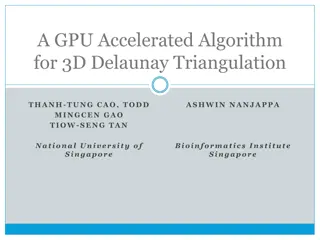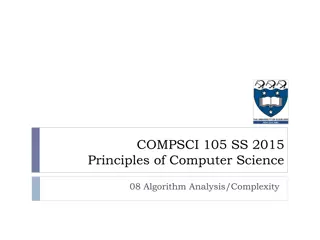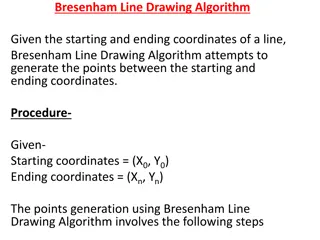
Master Data Structures and Algorithms for Efficient Programming
Learn the foundations of data structures and algorithms to enhance your programming skills. Understand the importance of algorithmic thinking, problem-solving, and computational complexity. Explore the core logic of algorithms and their specifications for effective performance analysis.
Download Presentation

Please find below an Image/Link to download the presentation.
The content on the website is provided AS IS for your information and personal use only. It may not be sold, licensed, or shared on other websites without obtaining consent from the author. If you encounter any issues during the download, it is possible that the publisher has removed the file from their server.
You are allowed to download the files provided on this website for personal or commercial use, subject to the condition that they are used lawfully. All files are the property of their respective owners.
The content on the website is provided AS IS for your information and personal use only. It may not be sold, licensed, or shared on other websites without obtaining consent from the author.
E N D
Presentation Transcript
Advance Algorithm Unit-1 Introduction State Institute of Engineering & Technology Nilokheri,132117 Department: Computer Engineering
Data structure and Algorithm are foundation of computer programming. Algorithmic thinking, problem solving and data structures are vital for software engineers. Computational complexity is important for algorithm design and efficient programming.
Data structures andAlgorithms are the fundamentals of programming. In order to become a good developer it is essential to master the basic data structures and algorithms and learn to apply them in the right way.
WHAT IS AN ALGORITHM? An algorithm is a finite set of instructions or logic, written in order, to accomplish a certain predefined task.Algorithm is not the complete code or program, it is just the core logic(solution) of a problem, which can be expressed either as an informal high level description as pseudocode or using a flowchart.
Algorithm Specifications Every algorithm must satisfy the following specifications... Input - every algorithm must take zero or more number of input values from external. Output - every algorithm must produce an output as result. Definiteness - every statement/instruction in an algorithm must be clear and unambiguous (only one interpretation) Finiteness - for all different cases, the algorithm must produce Result within a finite number of steps. Effectiveness - every instruction must be basic enough to be carried out and it also must be feasible.
Performance Analysis What is PerformanceAnalysis of an algorithm? Performance of an algorithm is a process of making evaluative judgement about algorithms. Performance of an algorithm means predicting the resources which are required to an algorithm to perform its task.
An algorithm is said to be efficient and fast, if it takes less time to execute and consumes less memory space. The performance of an algorithm is measured on the basis of following properties : Space Complexity Time Complexity
Space Complexity Its the amount of memory space required by the algorithm, during the course of its execution. Space complexity must be taken seriously for multi-user systems and in situations where limited memory is available. An algorithm generally requires space for following components : Instruction Space : Its the space required to store the executable version of the program. This space is fixed, but varies depending upon the number of lines of code in the program. Data Space : Its the space required to store all the constants and variables value. Environment Space : Its the space required to store the environment information needed to resume the suspended function.
int square(int a) { Constant Space Complexity return a*a; } If any algorithm requires a fixed amount of space for all input values then that space complexity is said to be Constant Space Complexity.
Linear Space Complexity int sum(int A[], int n) { int sum = 0, i; for(i = 0; i < n; i++) sum = sum + A[i]; return sum; } If the amount of space required by an algorithm is increased with the increase of input value, then that space complexity is said to be Linear Space Complexity
Time Complexity The time complexity of an algorithm is the total amount of time required by an algorithm to complete its execution. If any program requires fixed amount of time for all input values then its time complexity is said to be ConstantTime Complexity int sum(int a, int b) { return a+b; }
Linear Time Complexity If the amount of time required by an algorithm is increased with the increase of input value then that time complexity is said to be Linear Time Complexity int sum(int A[], int n) { int sum = 0, i; for(i = 0; i < n; i++) sum = sum + A[i]; return sum; }
Asymptotic Notation Asymptotic notation of an algorithm is a mathematical representation of its complexity Majorly, we use THREE types ofAsymptotic Notations and those are as follows... Big - Oh (O) Big Omega( ) Big-Theta( )
Big - Oh Notation (O) Consider function f(n) the time complexity of an algorithm and g(n) is the most significant term. If f(n) <= C g(n) for all n >= n0, C > 0 and n0 >= 1. Then we can represent f(n) as O(g(n)). f(n) = O(g(n))
How To Calculate Time Complexity? Now the most common metric for calculating time complexity is Big O notation. This removes all constant factors so that the running time can be estimated in relation to N, as N approaches infinity. In general you can think of it like this : statement; Above we have a single statement. Its Time Complexity will be Constant. The running time of the statement will not change in relation to N.
for(i=0; i < N; i++) { statement; } The time complexity for the above algorithm will be Linear. The running time of the loop is directly proportional to N. When N doubles, so does the running time.
for(i=0; i < N; i++) { for(j=0; j < N;j++) { statement; } } This time, the time complexity for the above code will be Quadratic. The running time of the two loops is proportional to the square of N. When N doubles, the running time increases by N * N.
while(low <= high) { mid = (low + high) / 2; if (target < list[mid]) high = mid - 1; else if (target > list[mid]) low = mid + 1; else break; } This is an algorithm to break a set of numbers into halves, to search a particular field(we will study this in detail later). Now, this algorithm will have a Logarithmic Time Complexity. The running time of the algorithm is proportional to the number of times N can be divided by 2(N is high-low here). This is because the algorithm divides the working area in half with each iteration.
void quicksort(int list[], int left, int right) { int pivot = partition(list, left, right); quicksort(list, left, pivot - 1); quicksort(list, pivot + 1, right); } Taking the previous algorithm forward, above we have a small logic of Quick Sort. Now in Quick Sort, we divide the list into halves every time, but we repeat the iteration N times(where N is the size of list). Hence time complexity will be N*log( N ). The running time consists of N loops (iterative or recursive) that are logarithmic, thus the algorithm is a combination of linear and logarithmic.
Big - Omege Notation () Big - Omega notation is used to define the lower bound of an algorithm in terms of Time Complexity. Consider function f(n) the time complexity of an algorithm and g(n) is the most significant term. If f(n) >= C x g(n) for all n >= n0, C > 0 and n0 >= 1. Then we can represent f(n) as (g(n)). f(n) = (g(n))
Big - Theta Notation () Big - Theta notation is used to define the average bound of an algorithm in terms of Time Complexity. Consider function f(n) the time complexity of an algorithm and g(n) is the most significant term. If C1g(n) <= f(n) >= C2 g(n) for all n >= n0, C1, C2 > 0 and n0 >= 1. Then we can represent f(n) as (g(n)). f(n) = (g(n))
NOTE : In general, doing something with every item in one dimension is linear, doing something with every item in two dimensions is quadratic, and dividing the working area in half is logarithmic.
Some Terminology For Binary Search Tree The successor nodes of a node are called its children The predecessor node of a node is called its parent The "beginning" node is called the root (has no parent) A node without children is called a leaf
Some Terminology (Contd) Nodes are organize in levels (indexed from 0). Level (or depth) of a node: number of edges in the path from the root to that node. Height of a tree h: #levels = l not full! (Warning: some books define h as #levels-1). Full tree: every node has exactly two children and all the leaves are on the same level.
Binary Search Trees (BSTS) Binary search tree property: the value stored at a node is greater than the value stored at its left child and less than the value stored at its right child.
Inorder Visit second tree J T E A H M Y Visit left subtree first Visit right subtree last
Preorder Visit first tree J T E A H M Y Visit right subtree last Visit left subtree second
Postorder Visit last tree J T E A H M Y Visit left subtree first Visit right subtree second
Recurrence Relations A recurrence relation for the sequence {an} is an equation that expresses an is terms of one or more of the previous terms of the sequence, namely, a0, a1, , an-1, for all integers n with n n0, where n0 is a nonnegative integer. A sequence is called a solution of a recurrence relation if it terms satisfy the recurrence relation.
Substitution method The most general method: Guess the form of the solution. Verify by induction. Solve for constants. Example:T(n) = 4T(n/2) + 100n [Assume that T(1) = (1).] Guess O(n3) . (Prove O and separately.) Assume that T(k) ck3 for k < n . Prove T(n) cn3 by induction.
Example Of Substitution = + T ( n ) 4 T ( n / 2 ) 100n + 3 + 4 c ( n / 2 ) 100n = 3 ( c / 2 ) n 100n = 3 3 cn (( c / 2 ) n 100n ) desired residual desired 3 cn whenever (c/2)n3 100n 0, for example, if c 200 and n 1. residual
Recursion-tree method A recursion tree models the costs (time) of a recursive execution of an algorithm. The recursion tree method is good for generating guesses for the substitution method. The recursion-tree method can be unreliable, just like any method that uses ellipses ( ). The recursion-tree method promotes intuition, however.
Example Of Recursion Tree Solve T(n) = T(n/4) + T(n/2) + n2: n2 2 n (n/2)2 (n/4)2 5n 2 16 (n/8)2 (n/4)2 (n/16)2 (n/8)2 25n 2 256 ( 1 ) ( ) 16 ( ) 16 (1) 2 3 + + + + 2 n 5 5 5 Total = 16 geometric series = (n2) Appendix: geometric series
The Master Method The master method applies to recurrences of the form T(n) = a T(n/b) + f (n) , where a 1, b > 1, and f is asymptotically positive.
Three Common Cases 1. f(n) = O(nlogba ) for some constant > 0. f(n) grows polynomially slower than nlogba (by an n factor). Solution: T(n) = (nlogba) .
2. f(n) = (nlogba lgkn) for some constant k 0. f(n) and nlogba grow at similar rates. Solution: T(n) = (nlogba lgk+1n) .
3. f(n) = (nlogba + ) for some constant > 0. f(n) grows polynomially faster than nlogba (by an n factor), andf(n) satisfies the regularity condition that af(n/b) cf(n) for some constant c < 1. Solution: T(n) = (f(n)) .
Examples Ex. T(n) = 4T(n/2) + n3 a = 4, b = 2 nlogba = n2; f(n) = n3. CASE 3: f(n) = W(n2+ e) for e = 1 and 4(cn/2)3 cn3 (reg. cond.) for c = 1/2. T(n) = Q(n3). Ex. T(n) = 4T(n/2) + n2/lgn a = 4, b = 2 nlogba = n2; f(n) = n2/lgn. Master method does not apply. In particular, for every constant e > 0, we have ne= w(lgn).

